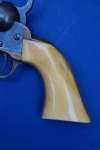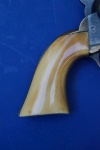
|
Colt 1862 Pocket Police Revolver Cased w/ Accessories --Untouched Time Capsule with Railroad and Kansas City History-- |
This is a fantastic example of a Colt Model 1862 Pocket Police Revolver in its original case with accessories. The serial number is in the 35,000 range and was made in 1867. It has a desirable 6-1/2" barrel with five shot cylinder in .36 caliber. All matching. The case includes the original 250 Count Goldmark Cap Tin for Colt Revolvers, an original packet of Hazard's rolled cartridges, extra round and conical lead balls, bullet mold, powder flask, key, and a home-made wooden cleaning rod which has been in the case since new. The revolver and accessories are quite literally worn into the lining of the case. That said, every once in a while, we come across an old cased Colt Revolver like this that has somehow escaped being disturbed where the outlines of every accessory has made its mark into the velvet lining. One of the things where I've had a standing disagreement with some dealers and collectors is the carefree attitude towards piecing out these cases in order to upgrade another or to simply make more money. I will never forget a gentleman calling me years ago who had his great-great-grandfather's No. 1, 1st Issue Silver Plated Smith and Wesson still in the original gutta percha case. By the time I received his pictures and called him to make a sizable offer, he already consigned it with a nearby auction house who convinced him it was better to sell the revolver and the case separately in order to realize more money. For a few extra dollars, they separated 150 years of history for forever. That said, this set needs to be left just the way it is. It is literally a time capsule to what was being used in 1860's era Missouri on the railroad. This cased Colt 1862 is as untouched an example as we've ever seen. It not only looks like it's been together since 1867, but when you open the case, it literally smells like it's been together its whole life. That said, if you're a collector who doesn't care about history or needs some part of this to upgrade another set, please look elsewhere. This needs to go to someone who'll continue what has literally been an unbroken chain of 152 years of careful stewardship dating back to the original owner. What's more, we know the name of the original owner who was a successful railroad agent, educator, and once mayor of Kansas City during the time when native sons and outlaws Jesse and Frank James were active in Missouri. From the accompanying letter dated 1980 dated from his descendants, this Colt revolver originally belonged to a man named Charles Chace. According to the letter, Chace worked for a railroad around the time of completion of the transcontinental railroad in the 1860's as well as having been elected mayor of Kansas City, Missouri at one time. Based on that and the all-knowing internet, we learned that the information in the letter is fairly accurate although the story probably lost some of the specifics over the decades regarding Chace's employment with the railroad. He was mayor of Kansas City and he was a railroad man but it appears unlikely Chace ever worked specifically for the Union Pacific Railroad. A more accurate summation would be that he worked during the time of the transcontinental railroad construction for two smaller railroads, one of which would become a part of the first transcontinental railroad and the first railroad built out of Chicago. He was first employed by the Chicago and Galena Union Railroad in Illinois during the late 1850's. He was then employed by the Hannibal, Quincy and Saint Joseph Railroad in Missouri throughout the 1860's. This would have been through the Civil War and afterwards. One can only imagine how many soon to be well-known outlaws Chace would have encountered on the railroad and in his stations. Certainly he had to have to been aware of the threat which is why he purchased this revolver. In addition, here is what we were able to come up with. Chace was born in 1835 in Austerlitz, Columbia Count, NY. His father was a farmer and he received his education in Monroe County and later the Rochester Collegiate Institute where he studied commerce or business. In 1852, he married Miss Martha E. Dryer of Brighton, NY. During this time, he was also elected superintendent of schools in Brighton, NY for two years. From there, Chace moved west to Rockport, Illionois in the latter part of the 1850's where he found a position with the Chicago and Galena Union Railroad. He was first made a ticket agent but after six weeks was sent to the end of the road at Warren and placed in charge of all stations from Freeport to Warren, IL; about 25 miles of track. From this time on he was in charge of all new stations as the rail line progressed. After the road was opened, he was ordered to move to the Dixon Air Line, Dixon, IL, where he opened all the stations from there to Fulton on the Mississippi River and appointed agents to man them. He joined the Masons in 1855 in Dixon and was Master of the Lodge in Fulton, IL for three years. In 1859, Mr. Chace resigned his position and in the spring of 1861 came to Missouri where he was appointed station agent at Iatan, MO for the Hannibal, Quincy, & St. Joseph Railroad which he held for the next two years. This would have taken place during the Civil War, a dangerous period when Missouri was torn between Union and Southern sympathies. This Colt revolver was made in 1867 and according to Chace's family, it was used on a pay car for the railroad. As the rail line advanced, he was moved to Weston, MO where he lived for four years. On the completion of the road to Kansas City in 1867, he moved to the city and was appointed general agent there which is likely when and where he acquired this Colt. In 1873, Chase returned to education where he was elected to the Board of Education in which he served two consecutive three year terms. He was also operated a feed and grain business at 1306 Grand St. and a partner in the Sheridan Hotel at 212 West Fifth St, Kansas City. Chace was elected Mayor of Kansas City in 1880 in which he served one term from 1880-1882. At some point after serving as mayor, Charles and his wife Martha moved back to New York where he passed away in 1900. From there, this Colt revolver was given to Ralph Bronson; perhaps a nephew on Martha's side of the family, then around 1920 to one Theodore Benedict who was a great nephew to Martha. Benedict wrote the letter about this revolver in 1980 in which he indicates he had owned it for sixty years at which time he was selling it to a collector in New York. For the next nearly forty years, it stayed in one collection until we acquired in March of this year. Overall, this Colt remains in NRA Antique Excellent Condition with 90% of its strong almost wet-ink-like blue black charcoal blue which normally flaked off from handling and heat expansion during firing. The cylinder is a strong 75-80% with a bit more edge wear from resting in the case. The frame shows 93% of its strong bright original case colors as does the hammer and loading lever. Being enclosed in a dark case for nearly its entire life, these colors are still bright and vivid and remain un-faded from wear and sunlight. The screws are in Very Good to Fine Condition still retaining 80-90% of their original fire blue. The brass triggerguard and backstrap have aged to a nice untouched buttery patina with what appear to be traces of blackened original silver plating in the protected areas. To find a Colt percussion in this condition with such little silver is often perplexing to newer collectors especially when you see well worn examples like the 1849 and 1851 Navy from the 1850's era with over half of their silver plating. My theory is this: After the Colt factory was destroyed in early 1864, Colt should have gone out of business but Samuel Colt's widow Catherine was determined to rebuild the company to honor her husband. Colt slowly got back off the ground and with the Civil War over as of 1865, found their gov't orders gone and a market flooded with Civil War surplus weapons. In order to save money, the silver plating that went onto their gripstraps got much thinner. We sometimes joke that it must have been only an atom or two thick...just long enough for the customer to get home with it before it started wearing through. That said, years ago I purchased a nearly mint example from a well-known collector named Bobby Smith that was exactly like this one...high condition with little to no silver plating left. See the following link: http://www.antiquearmsinc.com/colt-1862-police-revolver.htm The grips have are excellent with no chips, no repairs, having aged to a pleasing light yellow. There is one very minor fissure on the base of the right grip panel from natural aging that has been there for forever; otherwise, they are perfect and absolutely exceptional for 150+ years old. The case is in Fine condition retain 95% of its original varnish and plain unfinished base wood. The lid is solid with no cracks, just a minor scratch near the hinge. The lid to body is even with no warpage or curl. The inner works of the original lock have frozen over time but they may loosen with a little oil. We did not want to run the risk of staining the case so we will leave that for someone else to decide. The interior maroon lining is intact and fading to a light reddish brown like they always do when you see an original. Accessories are all in beautiful condition and the Hazard Packs of cartridge skins are wedged into the lower compartment tightly....we leaving them just as we found them...undisturbed. They don't come much better than this and rarely with this kind of history. Item# i61 SOLD |
 |
 |
 |
 |
 |
 |
 |
 |
 |
 |
 |
 |
 |
 |
 |
 |
 |
 |
 |
 |
 |
 |
 |
 |
 |
 |
 |
 |
 |
 |
 |
 |
 |
 |
 |
 |
 |
 |
 |
 |
 |
 |
 |
 |
 |
 |
 |